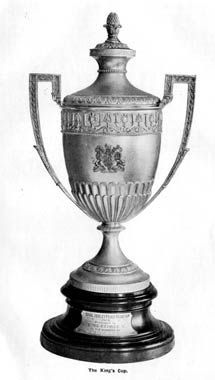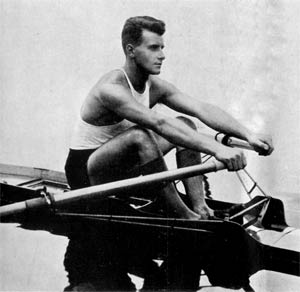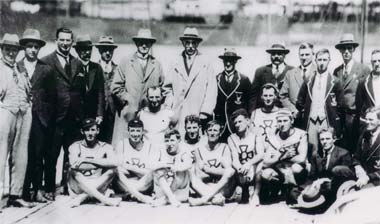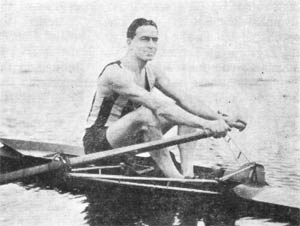
Sydney Rows
A Centennial History of the Sydney Rowing Club, 1970, by A L May
Table of Contents
Chapters
- Preliminaries: before 1870
- Foundations: 1870-1880
- New Clubs: 1880-1890
- The Amateur Question: 1890-1900
- Sydney on Top: 1900-1910
- Henley and War: 1910-1920
- Pearce and Mosman: 1920-1930
- Financial Problems: 1930-1940
- War and Wood: 1940-1950
- Strength and Stability: 1950-1960
- On Top Again: 1960-1970
Appendices
7. Pearce and Mosman: 1920-1930
Racing
The decade opened with strong efforts being made to have the King's Cup attached to the interstate race as a permanent trophy. Immediately after the win in 1919, the Cup had been taken possession of by the AIF Sports Control Board, passing from it to the Australian War Museum Committee in Melbourne. The Committee refused to part with the Cup and, on 30 October, 1920, a petition to the King from Captain Disher, stroke of the winning eight, was despatched by the VRA via the Governor-General.
The petition set out the facts of the matter, including "that all of the members of the crew and soldier oarsmen generally throughout the Commonwealth of Australia desire that the Cup should be treated as a perpetual trophy" for the annual interstate event. Captain Disher prayed "that Your Majesty may be graciously pleased to make known your wishes in regard to the disposal of the said Trophy". No answer had been received by the time of the 1921 race but, on 13 May, 1921, a letter was sent by Winston S. Churchill, Secretary of State for the Colonies, to the Governor-General informing him that the matter had been laid before the King. The result was as had been hoped: "His Majesty commands me to inform you that it is his wish that the Cup should be used as a permanent trophy and be competed for annually in the Interstate Eight-Oar Race of Australia".

The King's Cup in 1919
The champion eights of NSW in 1920/21 was won by Leichhardt. Balmain was second while Drummoyne started - its first race ever - and finished fourth (although its crew included four former Enterprise oarsmen). Sydney started no eight, but was having some success in maiden and lightweight races.
Three new selectors were appointed for 1921: Keary, Wood and Kolts. Their crew included two Leichhardt men, two from University and one each from Balmain, Mosman, Glebe and Drummoyne. Only Callaghan and McGill from the 1920 crew regained selection, although Wally Furlong, Balmain's coach, was given the coaching berth once again. The Murray Bridge crew, having won the South Australian championship eights by 10 lengths, started firm favorites for the interstate race, held in Tasmania on Anzac Day, 1921. The best they could do, however, was fourth, with a very fit WA crew recording its first-ever win by beating Tasmania by 3/4 length with Victoria 8 lengths back third. NSW trailed the field. Westbrook of Tasmania won the sculls, the NSW entrant, R. Neilson, being disqualified for fouling.
Sydney's regatta was amongst the first of the eight regattas held in the 1921/22 season. A feature was the unveiling of the club's Honour Roll by Sir Henry Braddon. A race for members only was on the programme but this practice among clubs had, by now, been almost abandoned.
The champion eights were rowed in December, 1921, and Mosman romped home by 10 lengths. A new era had begun. Mosman also took the champion fours in February, 1922, while Arthur Bull of Leichhardt won the champion sculls. Selectors of the NSW eight for the first-ever "King's Cup" were Hence, Furlong, and Aylwin of Mosman. Their final crew included five Mosman men - Pfafflin, Tattersall, Boone and the Callaghan brothers - plus McGill and Bryant of Leichhardt and Hancock of Glebe. Ossie Wood, Mosman's coach, was selected as coach of the crew.

Arthur Bull
All six States were represented once again on the Parramatta. This time, the Murray Bridge men did not let down their supporters. They won by 3 lengths from Victoria with WA third. NSW could do no better than fifth. Roger Fitzhardinge commented that NSW "never looked like an Interstate eight" and he called for a return to the style of coaching laid down in the Association's booklet. Bull used his knowledge of the Parramatta's tidal flows to great advantage to win the sculls. (As in previous cases, organization of the regatta placed a great load on the Association and its officials. Four sub-committees were set-up to handle the matter: finance, advertising, entertaining, and racing, with a total of 27 people involved on them. All worked smoothly once again.)
The "Murray cods" dominated rowing in SA and in Australia as well in 1922/23. Their supporters also started to plan for the 1924 Olympic Games in Paris. At Henley-on-Yarra in October, 1922, Murray Bridge won the Stewards' Challenge Cup for fours for the fourth time in a row. In NSW, Mosman won the champion fours and also the champion eights, beating Leichhardt in the latter by 6 lengths.
Two new championship events were introduced - lightweight fours and lightweight eights - with Balmain and Leichhardt winning respectively. Sydney continued to have no success at all.
Three new NSW selectors were tried for the 1923 King's Cup event: Fitzhardinge, Middleton and MacKenzie. Many of the previous year's crew promptly declared themselves unavailable and the final crew included not one of them. Chosen were two men from each of Leichhardt, University and Balmain and one each from Mosman and Drummoyne. Ernie Keary was appointed coach. One consequence of the crew's selection was that Mosman easily won the Riverview Gold Cup.
To help the NSWRA raise funds to send its crew to Perth for the race, a boxing and vaudeville night was held at Sydney Stadium. Conditions were such on the appointed day that the big races were put off and rowed two days later. SA won again, though beating WA by only 1/2 length with Victoria third and NSW well back fourth. NSW, however, lost Ridley of Leichhardt through illness and replaced him with a local WA man. Bull, the NSW champion, scored his second win in a row in the sculls in a most impressive fashion.
The 1923/24 season proved a very exciting one. There were three main reasons: Murray Bridge pursued its plan to represent Australia at the Olympics; the first official Henley-style regatta was held in NSW; and Mosman decided its entire crew should represent NSW in the King's Cup. Fund-raising to send the "Murray cods" to Paris commenced soon after the win in the 1923 King's Cup, but their path to Paris was an involved one.
The State Associations each nominated a representative to a selection panel to choose the Australian oarsmen. The Australian Olympic Federation agreed to send an eight if the panel recommended a particular crew and if their expenses were guaranteed. The selectors did choose the Murray Bridge crew but on condition they meet any challenges made on the Port Adelaide course. Bull was similarly nominated for the sculls. Several crews challenged Murray Bridge but, in March, 1924, they successfully survived the resulting contest and booked their passage.

The Murray Bridge crew after winning the test race
The initial NSWRA "Henley" was held in October, 1923. A regatta committee had been formed from representatives of clubs and a ladies' committee as well. Fifteen races were scheduled for Leichhardt canal with races each five minutes. The regatta was "so successful that it surprised even the most conservative members". About 8,000 people attended, the biggest rowing crowd for many years. The "Referee Henley Challenge Cup" for senior eights duly went to Mosman, while Leichhardt won the maiden eights and junior fours.
The Association's championship regatta was a month later and Mosman won the champion eights by 20 lengths from Drummoyne, although the latter eased off when they realised the situation. Bill Robertson of Leichhardt had an easy win in the champion sculls. Mosman also won the champion fours, rowed at their own regatta, by 2 1/2 lengths from Drummoyne. A ferry caused excitement when it ran down the umpire's launch, and three officials, Nat McDonald, Bill Hence and Wally Furlong, had to be rescued from the water by the water police. Sydney got up to win the lightweight maiden fours at this regatta, its greatest success for some time. Balmain won both lightweight championships.
Selection of the NSW eight presented difficulties. Keary, Middleton and Amess had been named selectors, but Mosman indicated its entire crew should represent the State and not be broken up. Amess and Middleton promptly resigned in protest. Their resignations were deferred by the Association and they were asked to select the best crew "regardless of ultimatums". The selectors chose six Mosman men and added Hurley of Leichhardt and Tancred of Drummoyne. After vigorous discussion, the Mosman members chosen agreed to row. With Ossie Wood coaching, the crew went on to record the best effort by NSW for several years-second by five feet to Queensland, with SA's "number 2" crew third. Victoria broke a rigger pin and finally swamped.
Lorimer of Leichhardt won the right to represent NSW in the sculls after a test race (Robertson being unavailable) but was unsuccessful. The big race had another incident: the NSW coach and the manager, Alderson, decided to drop Hurley and row with F. J. Hasemer, a former Mosman man temporarily resident in SA, but the SARA announced it would disqualify them if they did so. At a later Association meeting "the coach was severely criticised, the meeting expressing the opinion that any change in the crew should be notified to the NSWRA selectors and ratified before it was finally made".
The Olympic Games in Paris took place in July, 1924 and Australia was unsuccessful in the rowing events. The eight progressed well in training but was beaten by Italy and Spain in a heat of the Olympics themselves. The crew contested the repechages but finished third again behind Canada and Argentina. The result of the final was USA l, Canada 2, and Italy 3. Bull won through to the final of the sculls but was off-colour on the day itself and finished out of a place. Jack Beresford of England took the sculling title.
The major excitement of the 1924/25 season in Sydney was the presence of a NZ eight in the State championships. There were to be twelve regattas in all in the season, the opening one being the Association's second "Henley". A crowd of about 10,000 attended and saw Mosman again win the senior eights. Bert Goulding took the handicap sculls while the lightweight maiden four was won by a Mosman crew coached by Claude Rosevear and coxed by his son, Ossie. Despite the crowd, the regatta had so far failed to become the "social event" that had been hoped.
At the SRC regatta in January, 1925, Mosman rowed-over in the champion fours. The NZ representative eight arrived early in March, bringing with them a sectional eight. Eight-oared racing was still restricted in New Zealand and this was only the second time they had competed in eights (the first being in 1919). They gave an exhibition row at the Balmain-Drummoyne regatta and impressed local rowing types with their strong catch and leg drive and the tremendous rip at the finish. (Cabramatta competed at this regatta and won the maiden fours. They had, however, to come 20 miles for the race and "it was unique to see a motor lorry lumber down to the course with a four-oar boat on board".)
The visit of the New Zealanders attracted much attention to the championship "All Blacks" regatta, with 3,000 people following the races and about 10,000 lining the banks. "A wonderful crew - of wonderful stamina and combination - is the only way to describe the All Black eight", said one reporter. The crew beat Mosman by 3 lengths with the rest of the field no less than 30 lengths further back. St. Clair, the New Zealand sculler, beat Clyde Lorimer, now transferred to Sydney, by 25 lengths in the champion sculls of NSW.
The NZ eight was seen again in the Gold Cup regatta at Riverview and they won again beating Mosman by 3/4 length. St. Clair started in the handicap sculls but finished only fourth in a race won by Jack Goulding.
An inter-dominion fours was also staged at the regatta, with NZ finishing first and second after the only other competitor, Mosman, broke a slide when well behind and failed to finish. During their stay, the NZ crew was quartered at the SRC Branch, while a range of entertainment was organised for them.
It was now King's Cup time and the selectors, Keary, MacKenzie and T. P. Mitchell, chose a crew containing seven Mosman men with Tancred of Drummoyne in the bow seat. The race was rowed in Melbourne and WA won by 2 1/2 lengths from Tasmania with NSW 1/2 length back third. Cambridge of Victoria won the sculls with Lorimer, apparently over-trained, only fourth.
Mosman suffered defeat in Sydney during the 1925/26 season. In the opening regatta, University won the senior eights by a length, but Mosman easily won the champion fours soon after. The latter race was rowed at the combined regatta held by Sydney and University, an experiment recommended to clubs by an RA sub-committee which proved very successful (and even profit-making). All events were open. Henley-on-Yarra was rowed on the same day with 150,000 people present to see crews from NZ, Queensland, Tasmania and WA compete with Victorian clubs.
The Association's championship regatta in 1925 was significant for a number of reasons. Firstly, Mosman bowed to Leichhardt, coached by Ernie Keary, by 1/2 length in the champion eights. Secondly, Sydney won the lightweight champion fours, the club's first major rowing success for some time. The crew was Charlie Saleh (bow), Ross Parkinson, Bob Turnbull and Ken Preshaw (stroke), with Ossie and Claude Rosevear, now transferred from Mosman, cox and coach. Finally the champion sculls of NSW was won, amidst considerable controversy, by Milton Kent of Haberfield with Jack Goulding second. Kent, a former professional, had been reinstated by the Association some time before, an influencing factor being his devoted efforts in coaching amateur scullers, including Bull and Lorimer.

Milton Kent
The Association's Henley regatta was not held in 1925/26 as the Committee considered "the Association's financial position did not justify the monetary risk". Nevertheless, Leichhardt and Haberfield combined to stage a regatta on the canal in February, and Balmain, Drummoyne and Glebe also followed the trend to larger and more profitable combined regattas. A series of wins to Sydney in maiden and junior races was a feature of the remaining regattas. The crews were coached by George MacKenzie and included Mick MacKenzie, his son, Fred Pike, Arthur Cashman, Frank Lester, G. Stone and D. Armstrong.
